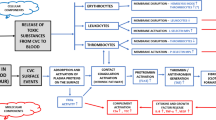Summary
The Erlanger silver catheter consists of a new form of polyurethane, which contains finely dispersed metallic silver. The aim of this study was to establish the biocompatibility of this intravenous catheter by investigating the acute cytotoxicity of extracts from the Erlanger silver catheter on human fibroblasts and lymphocytes. Extracts of the Erlanger silver catheter were not cytotoxic for MRC-5 human fibroblasts nor for sensitized phytohem-agglutinin (PHA)-stimulated human lymphocytes. The addition of silver powder of up to 2% by weight to the basic catheter polyurethane TecothaneTM led to no increase in acute cytotoxicity in comparison with untreated TecothaneTM. The Erlanger silver catheter is a new intravenous catheter with good biocompatibility.
Similar content being viewed by others
References
Bach, A., Böhrer, H.: Infektionen durch intravasale Katheter. Anästesiol. Intensivmed. Notfallmed. Schmerzther. 28 (1993) 404–414.
Bach, A., Böhrer, H., Motsch, J., Geiss, H. K., Martin, E., Sonntag, H. G.: Prevention of bacterial colonization of intravenous catheters by aseptic impregnation of polyurethane polymers. J. Antimicrob. Chemother. 33 (1994) 969–978.
Pettigrew, R. A., Lang, S. D. R., Haydock, D. A., Parry, B. R., Bremner, D. A., Hill, G. L.: Catheter related sepsis in patients on intravenous nutrition: a prospective study of quantitative catheter cultures and guidewire changes for suspected sepsis. Br. J. Surg. 72 (1985) 52–55.
Norwood, S., Ruby, A., Civetta, J., Cortes, V.: Catheter-related infections and associated septicemia. Chest 99 (1991) 968–975.
Williams, R. L., Doherty, P. J., Vince, D. G., Grashoff, G. J., Williams, D. F.: The biocompatibility of silver. Critical Reviews in Biocompatibility 5 (1989) 221–243.
Biological Evaluation of Medical Devices—Part 5: Tests for cytotoxicity,in vitro methods. 1st ed. 1992 (Reference number ISO 10993-5: 1992 (E)).
The United States Pharmacopeial Convention, Inc.: Official reference standards (effective: February 9, 1995).
Mossman, T.: Rapid colorimetric assay for cellular growth and survival: application to proliferation and cytotoxicity assays. J. Immunol. Meth. 65 (1983) 55–63.
Steffensen, I. L., Mesna, O. J., Andruchow, E., Namork, E., Hylland, K., Andersen, R. A.: Cytotoxicity and accumulation of Hg, Ag, Cd, Cu, Pb and Zn in human peripheral T and B lymphocytes and monocytesin vitro. Gen. Pharmac. 25 (1994) 1621–1633.
Zhao, G., Stevens, E.: Multiple parameters for the comprehensive evaluation of the susceptibility ofEscherichia coli to the silver ion. BioMetals 11 (1999) 27–32.
Author information
Authors and Affiliations
Rights and permissions
About this article
Cite this article
Greil, J., Spies, T., Böswald, M. et al. Analysis of the acute cytotoxicity of the erlanger silver catheter. Infection 27 (Suppl 1), S34–S37 (1999). https://doi.org/10.1007/BF02561615
Issue Date:
DOI: https://doi.org/10.1007/BF02561615




